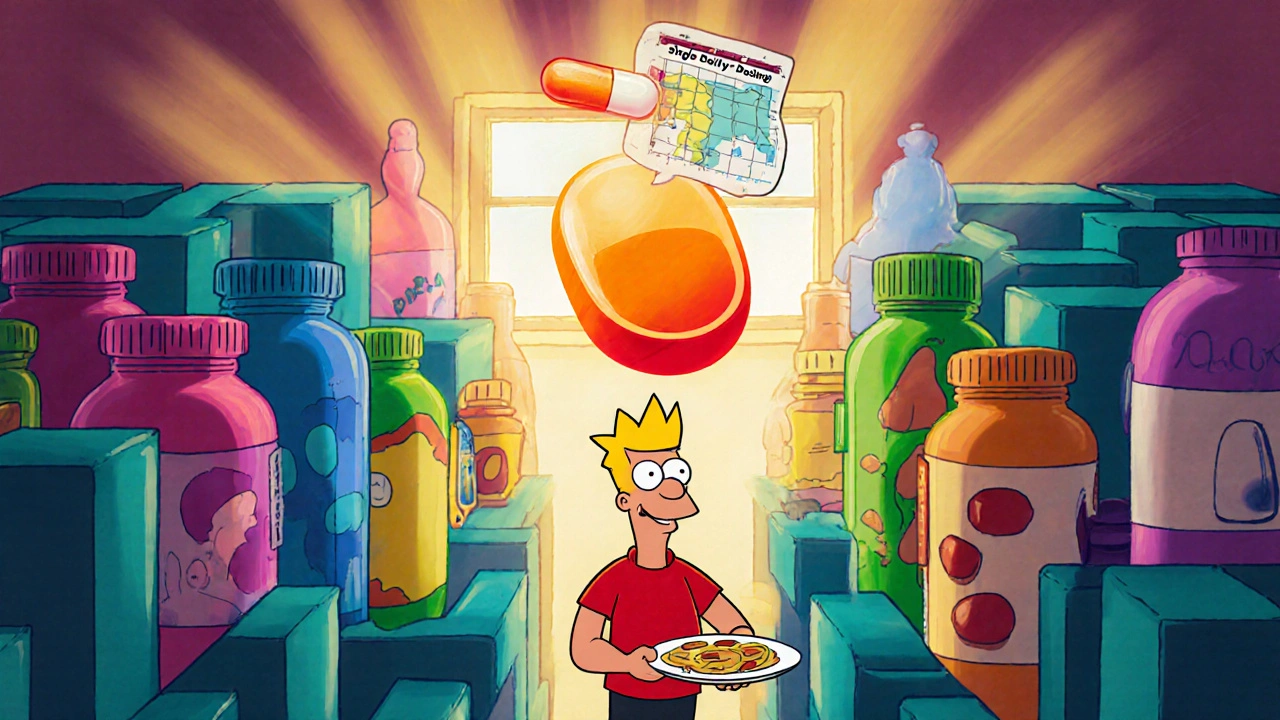Diabetes Medication Selector
Personalized Medication Recommendation
Select your health profile to find the most appropriate medication for your type 2 diabetes management.
Note: This tool provides general guidance. Always consult your healthcare provider before making any changes to your diabetes treatment.
Choosing the right pill to keep blood sugar in check can feel like a maze. Amaryl is a brand name for glimepiride, a sulfonylurea that pushes the pancreas to release more insulin. It’s been on the market for decades, but newer drugs and older sulfonylureas offer different trade‑offs. This guide walks through how Amaryl works, who benefits most, and how it stacks up against the most common alternatives.
How Amaryl (Glimepiride) Works
Glimepiride binds to ATP‑sensitive potassium channels on pancreatic beta cells. By closing these channels, the cell membrane depolarizes, calcium floods in, and insulin secretion spikes. The result is a quicker drop in post‑meal glucose. Unlike some older sulfonylureas, glimepiride has a longer half‑life (about 5‑7 hours), allowing once‑daily dosing.
Key Benefits of Amaryl
- Effective at lowering HbA1c by 1‑1.5 % when added to metformin.
- Convenient single daily dose, usually taken with breakfast.
- Lower risk of severe hypoglycemia compared with first‑generation sulfonylureas.
- Proven track record in large outcome studies across diverse populations.
Common Drawbacks
- Weight gain of 2‑4 kg is typical.
- Risk of hypoglycemia rises in renal impairment or when combined with other insulin‑secretagogues.
- Not recommended as first‑line therapy for most patients; guidelines favor metformin first.
Alternative Sulfonylureas
Other sulfonylureas share the same insulin‑boosting mechanism but differ in potency, half‑life, and side‑effect profile.
Glipizide is a second‑generation sulfonylurea with a shorter half‑life (2‑3 hours), making it a good option for patients who need tighter control around meals.
Glyburide (also called glibenclamide) has a long half‑life and higher potency, but it carries a higher hypoglycemia risk, especially in the elderly.

Non‑Sulfonylurea Oral Options
Guidelines often recommend stepping away from sulfonylureas after metformin because newer classes address insulin resistance or glucagon excess without driving beta‑cell exhaustion.
Metformin reduces hepatic glucose production and improves peripheral insulin sensitivity. It’s weight‑neutral and has cardiovascular benefits.
Sitagliptin is a DPP‑4 inhibitor that raises incretin levels, enhancing glucose‑dependent insulin release with minimal hypoglycemia risk.
Empagliflozin belongs to the SGLT2‑inhibitor class, which forces excess glucose out via the kidneys. It adds weight loss and heart‑failure protection.
Quick Comparison Table
| Drug | Class | Typical Dose | HbA1c Reduction | Weight Effect | Hypoglycemia Risk |
|---|---|---|---|---|---|
| Amaryl (Glimepiride) | Sulfonylurea | 1‑4 mg daily | 1‑1.5 % | +2‑4 kg | Low‑moderate |
| Glipizide | Sulfonylurea | 2.5‑10 mg daily | 0.8‑1.2 % | +1‑3 kg | Low |
| Glyburide | Sulfonylurea | 2.5‑10 mg daily | 1‑1.4 % | +2‑5 kg | High (especially elderly) |
| Metformin | Biguanide | 500‑2000 mg BID | 1‑1.5 % | Weight neutral or loss | Very low |
| Sitagliptin | DPP‑4 inhibitor | 100 mg daily | 0.5‑0.8 % | Neutral | Very low |
| Empagliflozin | SGLT2 inhibitor | 10‑25 mg daily | 0.5‑1 % | ‑1‑‑3 kg | Low (but genital infections possible) |
How to Choose the Right Medication
Every patient’s situation is unique. Below are the most common decision criteria and how Amaryl measures up.
- Renal function: Glimepiride needs dose adjustment when eGFR < 30 mL/min; metformin is contraindicated below 30 mL/min.
- Weight concerns: If a patient wants to lose weight, SGLT2 inhibitors or GLP‑1 agonists beat sulfonylureas.
- Cost: Generic sulfonylureas (glipizide, glyburide) and metformin are usually cheaper than brand‑name DPP‑4 or SGLT2 inhibitors.
- Hypoglycemia tolerance: Elderly or those with erratic meal patterns should avoid high‑risk sulfonylureas like glyburide.
- Cardiovascular risk: Empagliflozin and some GLP‑1 agents have proven heart‑failure benefits, which sulfonylureas lack.
Safety Profile and Side‑Effect Management
Understanding the side‑effect landscape helps clinicians and patients stay ahead.
- Hypoglycemia: Monitor blood glucose especially after missed meals or increased physical activity. A quick source of carbs (glucose tablets) can save a crisis.
- Weight gain: Pair glimepiride with lifestyle counseling or consider adding metformin to blunt the trend.
- Renal considerations: Check serum creatinine every 6‑12 months. If eGFR declines, switch to a drug with safer renal profile.
- Cardiovascular safety: No major signal for increased heart risk, but no proven benefit either.
Practical Tips for Patients on Amaryl
- Take the tablet with your first main meal of the day. Skipping breakfast can raise hypoglycemia risk.
- Keep a log of blood glucose before and after meals for the first two weeks. This helps fine‑tune the dose.
- Stay hydrated and monitor for signs of low blood sugar: shakiness, sweating, confusion.
- Inform your dentist before any procedures; some may recommend a temporary dose hold.
- Never double up the dose to "make up" a missed tablet. Instead, resume the normal schedule at the next meal.
When to Consider Switching from Amaryl
Even a well‑tolerated drug may become suboptimal over time. Consider a change if:
- HbA1c stays above 8 % after 3‑month dose optimization.
- Recurrent hypoglycemia episodes, especially nocturnal.
- Significant weight gain (>5 kg) affecting quality of life.
- New cardiovascular disease diagnosis-SGLT2 inhibitors or GLP‑1 agonists may offer protection.
Bottom Line
Amaryl (glimepiride) remains a solid, affordable option for many adults with type 2 diabetes, especially when cost is a major factor and renal function is acceptable. However, newer agents provide better weight and heart benefits with less hypoglycemia. The best choice hinges on individual health goals, comorbidities, and budget. Discuss the trade‑offs with your clinician to land on the regimen that keeps your sugars steady without unwanted side effects.
Frequently Asked Questions
Can I use Amaryl if I have kidney disease?
Glimepiride is cleared by the kidneys, so the dose must be reduced when eGFR falls below 30 mL/min. If kidney function drops further, doctors usually switch to a drug with a safer renal profile, such as a DPP‑4 inhibitor.
Why does Amaryl cause weight gain?
By stimulating more insulin, glimepiride promotes glucose storage in fat tissue. Adding lifestyle advice or metformin can offset the weight‑gain effect.
Is it safe to combine Amaryl with metformin?
Yes, the combination is common and often more effective than either drug alone. Metformin improves insulin sensitivity while glimepiride boosts insulin secretion, creating a complementary effect.
How quickly does Amaryl start lowering blood sugar?
Glimepiride begins to act within 1‑2 hours after ingestion, peaking around 4‑6 hours, and maintains a glucose‑lowering effect for roughly 12‑24 hours.
What are the main differences between Amaryl and glipizide?
Glipizide has a shorter half‑life, making it better for patients who need tighter control around meals, whereas Amaryl’s longer action suits once‑daily dosing. Both have similar efficacy, but glipizide may cause slightly less weight gain.

 Top 6 Neurontin Alternatives for Neuropathic Pain Management in 2024
Top 6 Neurontin Alternatives for Neuropathic Pain Management in 2024
 SSRIs and Opioids: Understanding Serotonin Syndrome Risk and How to Prevent It
SSRIs and Opioids: Understanding Serotonin Syndrome Risk and How to Prevent It
 Get Your Tadalista Prescription Online - Simple, Fast and Secure
Get Your Tadalista Prescription Online - Simple, Fast and Secure
 Cerebral Aneurysm: Understanding Rupture Risk and Modern Treatment Options
Cerebral Aneurysm: Understanding Rupture Risk and Modern Treatment Options
 Prophylaxis for Orthodontic Patients: Keeping Your Braces Clean and Effective
Prophylaxis for Orthodontic Patients: Keeping Your Braces Clean and Effective
Poornima Ganesan
October 18, 2025 AT 20:34Amaryl, known generically as glimepiride, has been a cornerstone of sulfonylurea therapy for decades, and its pharmacodynamics are often misunderstood by both patients and some clinicians. It binds to the ATP‑sensitive potassium channels on pancreatic beta cells, effectively mimicking the natural closure that occurs when glucose levels rise. This triggers depolarization, calcium influx, and a robust surge of insulin release, which can be particularly useful after carbohydrate‑rich meals. Because of its relatively long half‑life of five to seven hours, a single daily dose is sufficient for most adult patients, simplifying adherence compared with shorter‑acting agents. However, the longer exposure also means that hypoglycemia can occur several hours after dosing, especially if a meal is missed or delayed. The drug’s efficacy in lowering HbA1c by roughly one to one‑point‑five percent is well‑documented, yet this benefit comes with a predictable weight gain of two to four kilograms. Weight gain reflects the anabolic effect of higher insulin levels, encouraging glucose storage in adipose tissue. In patients with compromised renal function, the clearance of glimepiride is reduced, necessitating dose adjustments when eGFR falls below 30 mL/min. Moreover, the risk of severe hypoglycemia rises sharply in the elderly, who often have erratic eating patterns and may be on multiple interacting medications. While Amaryl is affordable and widely available, it lacks the cardiovascular and renal protective benefits that newer classes such as SGLT2 inhibitors and GLP‑1 receptor agonists provide. Consequently, guidelines favor metformin as first‑line therapy, reserving sulfonylureas like Amaryl for cases where cost constraints or specific clinical scenarios apply. If a patient experiences recurrent nocturnal hypoglycemia, a switch to a DPP‑4 inhibitor or low‑dose insulin may be prudent. Lifestyle counseling, particularly focused on diet and exercise, can mitigate the weight‑gain side effect and improve overall glycemic control. Some clinicians combine Amaryl with metformin to harness complementary mechanisms: metformin improves insulin sensitivity while glimepiride boosts insulin secretion. This combination can lower the required dose of glimepiride, thereby reducing hypoglycemia risk. Regular monitoring of blood glucose, especially after initiating or adjusting therapy, is essential to avoid dangerous lows. Finally, patient education about recognizing hypoglycemia symptoms-shakiness, sweating, confusion-cannot be overstated, as prompt carbohydrate intake can prevent severe outcomes.
Emma Williams
October 28, 2025 AT 01:47Thanks for the thorough overview, really helpful. Looking forward to discussing more.
Stephanie Zaragoza
November 6, 2025 AT 08:00While the article captures the essential pharmacologic actions of glimepiride, it omits several nuances that merit attention; for instance, the drug’s interaction with CYP2C9 polymorphisms can lead to variable plasma concentrations, thereby affecting both efficacy and safety. Moreover, the risk of hypoglycemia in patients with hepatic impairment is often understated, despite hepatic metabolism playing a non‑trivial role. The comparison table, though useful, fails to indicate the cost‑effectiveness ratios that are crucial for formulary decisions in many health systems. It is also worth noting that the combination of glimepiride with certain antibiotics, such as fluoroquinolones, may potentiate the hypoglycemic effect, necessitating dose adjustments. Finally, clinicians should remember that patient adherence improves when medication regimens are simplified, a factor that glimepiride’s once‑daily dosing conveniently supports.
Mike Hamilton
November 15, 2025 AT 14:14That is very well said. I think the key point is that you need to watch liver function. Also watch for other meds that can cause low blood sugar. Simple stuff but easy to miss.
Liberty Moneybomb
November 24, 2025 AT 20:27Did you know that the big pharma push for newer drugs is part of a hidden agenda to keep us dependent? They hide the fact that glimepiride works just as well for many people, yet they flood the market with pricey alternatives that claim "cardio‑protective" benefits while the data is murky at best. It feels like a coordinated effort to divert our attention and our wallets away from affordable, time‑tested treatments. And the way they market SGLT2 inhibitors as miracle pills? That's a classic ploy to stir fear of the old drugs.
Grace Hada
December 4, 2025 AT 02:40Amaryl is just cheap hype, nothing more.
Fabian Märkl
December 13, 2025 AT 08:54Hey, everyone! Great points made here 😄. If you’re on Amaryl, keep a log of your readings and stay active – it really helps.